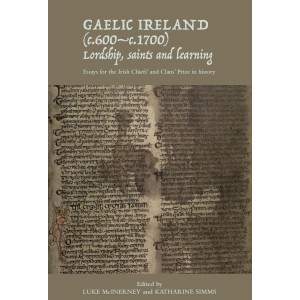This collection of studies on the history of Gaelic Ireland is the product of an essay competition sponsored jointly by the Standing Council of Irish Chiefs and Chieftains (Buanchomhairle Thaoisigh Éireann) and Clans of Ireland (Finte na hÉireann). The essays represent the winning entries and superior-quality submissions from 2018–20 and cover the early and medieval period from c. 600 to c. 1700. The topics under study are diverse and range from early medieval saints to Gaelic lordship in the high Middle Ages, and from archaeology to the custodians of Gaelic scholarship and learning, the Aos Dána class. Other themes under study throw new light on towerhouses, medieval literary texts, as well as on aspects of kinship and culture. The central focus is upon the Gaelic-Irish and Anglo-Norman population groups who were settled in Ireland during the period under study.
The first volume in this series, Gaelic Ireland (c. 600–c. 1700) politics, culture and landscapes, edited by Dr Katharine Simms (Wordwell, 2013), was the fruit of a competition initiated by the Standing Council of Irish Chiefs and Chieftains, with the object of both encouraging research into Gaelic Ireland among postgraduate historians, and of reaping the harvest of independent researchers within the bounds of an accessible, academic publication. The second volume, titled Politics, kinship and culture in Gaelic Ireland c. 1100–c. 1690, edited by Dr Joseph Mannion and Dr Katharine Simms (Wordwell, 2018), followed suit in 2018, taking as its core theme culture and kinship of the later medieval period.
The continuance of the competition and the appearance of this third anthology under the joint sponsorship of the Clans of Ireland and Standing Council of Irish Chiefs and Chieftains stands testament to the success of the original project and the wide appeal of Gaelic history and culture. The essay competition continues to this day, and it is hoped that it helps foster academic interest in this fascinating period of Irish history among new generations of historians and independent scholars.
Part I: Politics, culture and lordship
1. Hákon IV: the last Norse king of the Hebrides—and Ireland?
Simon Egan
2. The tánaiste and the ‘crown prince problem’
Matthew McGinty
3. The abduction of Dearbhforgaill and the expulsion of Diarmuid Mac Murchadha
Cormac Hickey
4.Divided by a common religion: ecclesiastical identity and the creation of a ‘savage other’ in medieval Dublin and Wicklow
Chris Lawlor
5. Uilliam Buide Ó Cellaig and the late medieval renaissance of the Uí Maine lordship
Daniel Curley
6. The Uí Allmhuráin (O’Hallorans) of Fahy: a study of a late medieval Thomond lineage
Robert O’Halloran
7. Dating, distribution, classification and development of some County Clare towerhouses
Martin Breen
8. Towerhouses and lordship in County Mayo
Declan Keenan
Part II: Saints, texts and contexts
9. Muirchú and the history of fifth-century Ulster
Patrick McDonagh
10. A window on twelfth-century Bréifne: a date and context for Vita Lasriani, the Latin Life of St Laisrén of Daiminis
Jesse Patrick Harrington
11. Mochta of Louth and the reworking of Irish history
Anthony Cronin
12. Early Christian settlements in Burrishoole, Co. Mayo
Breege Hyland
13. Did an early tradition of Gúaire as geilt exist? The evidence of Cat Cairn Chonaill
Aogán Ó hIarlaithe
14. The medieval routeways of Thomond in the time of the Caithréim Thoirdhealbhaigh
Vinicius Marino Carvalho
Part III: Scholarship, scholars and places
15. An Pháirc, Cois Fharraige, Co. Galway: the last residence and the schoolhouse of Ruaidhrí Ó Flaithbheartaigh
Damhnait Uí Mhaoldúin
16. The Clann Chraith bardic school of Burgess, south Tipperary
Luke McInerney and Caroline Smiddy
17. The early medieval scribes of the Life of Columba and the Book of Armagh and their knowledge of Greek
Sally Finn-Kelcey
ISBN: 978-1-913934-66-8 (Paperback)
ISBN: 978-1-913934-70-5 (Hardback)
ISBN: 978-1-913934-67-5 (Ebook)
228 pages illustrated
Hardback
€30
Publication date 19Novemebr 2021
Size 235 x 155mm
The editors
LUKE McINERNEY, MRSAI, is a native of Ballarat, Australia, and an independent researcher with a focus on the late medieval history of Gaelic Ireland. His ancillary interests include the economic and social structure of medieval lordships in Ireland, the medieval Gaelic Church, and the role and function of the Gaelic learned class. His publications can be found in Irish and international journals, such as Archivium Hibernicum, Studia Hibernica and Eolas: The Journal of the American Society of Irish Medieval Studies. His book on the links between the Gaelic learned class and the medieval Irish Church was published in 2014. He has held positions in central government and regulatory agencies, including at the Australian Federal Treasury in Canberra; HM Treasury at Westminster, London; and more recently at the Central Bank of Ireland in Dublin. He is currently Co-Vice Chair of the Clans of Ireland.
KATHARINE SIMMS, MRIA, FTCD, lectured in Medieval History at Trinity College Dublin to 2010. She has written From kings to warlords (1987), Medieval Gaelic sources (2009) and Gaelic Ulster (2020), as well as numerous articles on Gaelic Ireland in the thirteenth to fifteenth centuries.
| Details | |
| Author | Luke. McInerney and Katharine Simms (eds) |
| Publication Data | November 2021 |
| Subjects | History |
Gaelic Ireland (c.600–c.1700), Lordship, saints and learning. Essays for the Irish Chiefs’ and Clans’ Prize in History (Hardback Edition)
- ISBN: 978-1-913934-66-8
- Author(s): Luke. McInerney and Katharine Simms (eds)
- Availability: In Stock
-
€30.00
Related Products
Politics, kinship and culture in Gaelic Ireland, c. 1100–c. 1690. & Gaelic Ireland (c. 600–c. 1700): politics, culture and landscapes Studies for the ‘Irish Chiefs’ Prize
BUY ONE GET ONE FREEPolitics, kinship and culture in Gaelic Ireland, c. 1100–c. 1690. (Hardbac..
€55.00
Tags: Chief's Prize


-80x80.jpg)